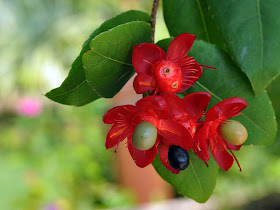The Olive-backed Sunbird (Nectarina jugularis) or Kelichap Bukit in Malay are very bold birds that freely build nests in my garden. One day while photographing some flowers I heard rustlings nearby. As I moved towards the source of the sound, I discovered the mystery of my denuded plastic stake used as a support for the Philodendron Imbe. The covering of coconut fibres was frayed.

A female sunbird was so absorbed at plucking the fibres that she was totally oblivious of my presence. In fact I was only about eight feet away from her. The upperpart is dull olive-green while the underpart is all yellow.

With flapping wings, it jerked some fibres out of the stake with ...
to tug at more fibres.
After more inspection and pecking, it flew off. I suspect that it would come back later to pick up the fibres that it dropped.
These unstaked Philodendron Imbe simply just sprawled invasively all over the flower bed, killing off the competition from other flowering plants.

The male sunbird appeared contented to leave nest-building to the female [as in humans, always so good at multi-tasking ;)]. Here, it's perched on a Thunbergia Grandiflora vine to take in the garden view.

Thunbergia Grandiflora


The male Olive-backed Sunbird is more colourful than the female which does not have the metallic blue colouring.

The orange-red semi-double Hibiscus rosa sinensis.
These unstaked Philodendron Imbe simply just sprawled invasively all over the flower bed, killing off the competition from other flowering plants.

The male sunbird appeared contented to leave nest-building to the female [as in humans, always so good at multi-tasking ;)]. Here, it's perched on a Thunbergia Grandiflora vine to take in the garden view.

Thunbergia Grandiflora

The forehead, throat and upper breast is metallic blue-black
contrasting with bright yellow
underparts. The upperpart is dull olive green just like the females. The feet are jet-black.

The male Olive-backed Sunbird is more colourful than the female which does not have the metallic blue colouring.

The orange-red semi-double Hibiscus rosa sinensis.


















































